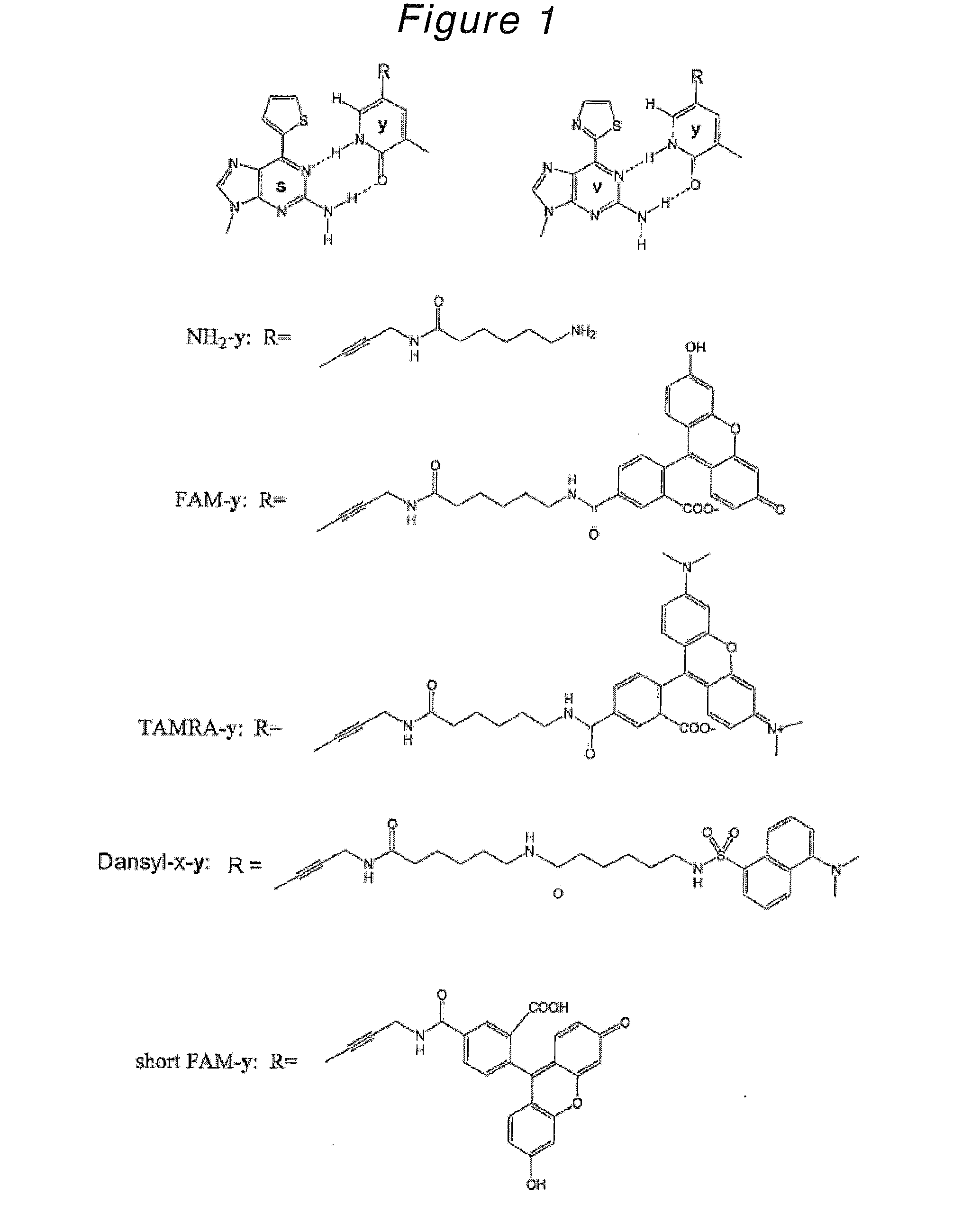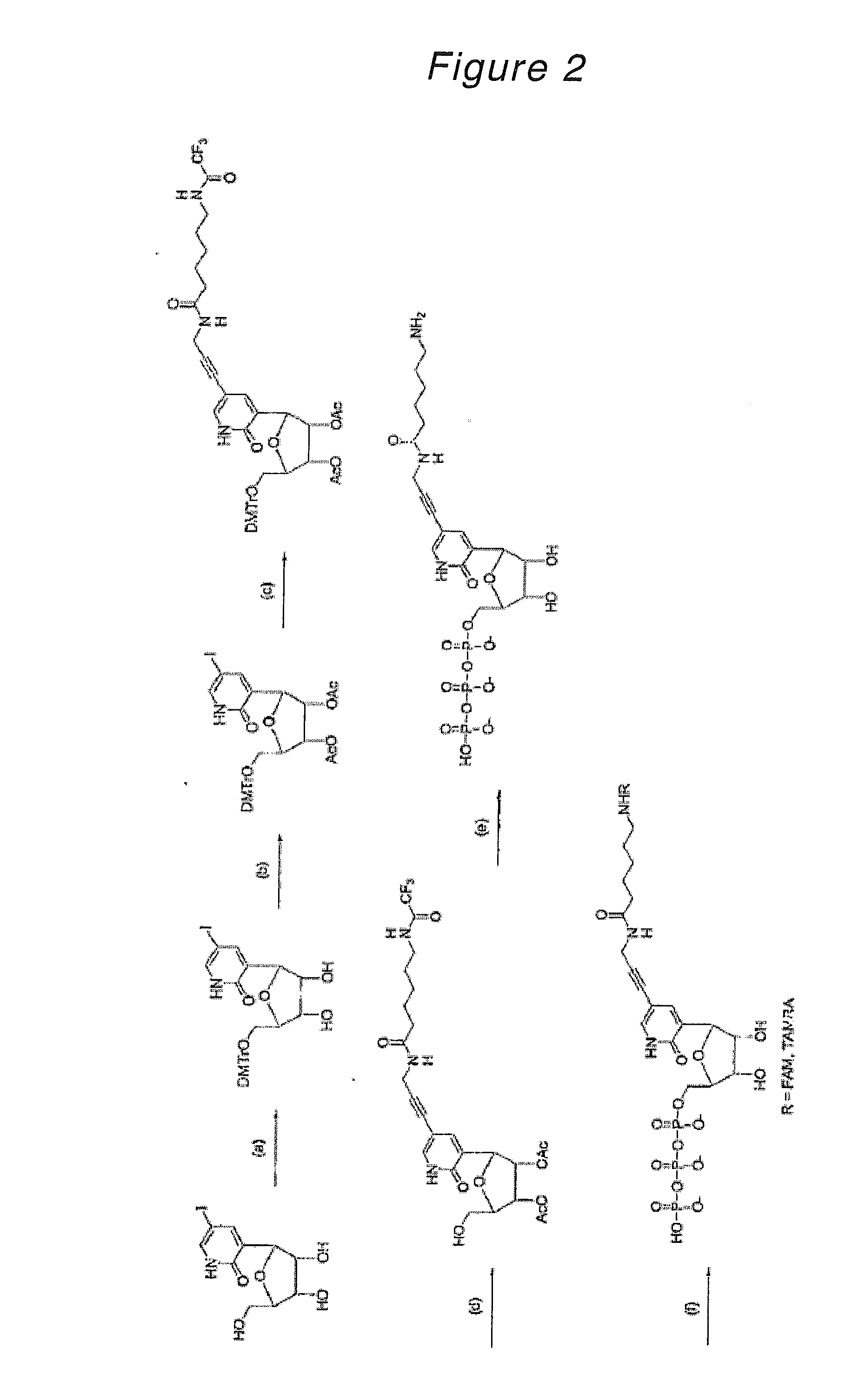Novel Nucleoside or Nucleotide Derivative and Use Thereof
a technology of nucleosides and derivatives, applied in the field of nucleosides or nucleotides having, can solve the problems of inherent problems of nucleic acids containing natural bases
- Summary
- Abstract
- Description
- Claims
- Application Information
AI Technical Summary
Benefits of technology
Problems solved by technology
Method used
Image
Examples
example 1
Synthesis of 3-(5-O-dimethoxytrityl-β-D-ribofuranosyl)-5-iodo-2-oxo(1H)pyridine
[0204]3-(β-D-Ribofuranosyl)-5-iodo-2-oxo(1H)pyridine (178 mg, 505 μmol) was azeotroped three times with anhydrous pyridine in a 10 ml recovery flask and dissolved in anhydrous pyridine (5 ml, 0.1 μM). To this solution, dimethoxytrityl chloride (183 mg, 540 μmol) was added and stirred at room temperature for 1.5 hours. The reaction mixture was poured into ethyl acetate / water and the aqueous layer was removed. The organic layer was washed twice with saturated aqueous sodium bicarbonate, dried over magnesium sulfate and then evaporated to remove the solvent. The resulting crude product was purified by silica gel column chromatography (developing solvent; dichloromethane:methanol=100:0→100:2) to give the desired product as a light-yellow amorphous substance (272 mg, 416 μmol, yield 82%).
[0205]1H NMR (270 MHz, DMSO-d6) δ 3.09-3.20 (m, 2H), 3.70-3.86 (m, 8H), 3.92-3.94 (m, 1H), 4.73-4.76 (m, 2H), 5.27 (bs, 1H),...
example 2
Synthesis of 3-(2,3-di-O-acetyl-5-O-dimethoxytrityl-β-D-ribofuranosyl)-5-iodo-2-oxo(1H)pyridine
[0206]3-(5-O-Dimethoxytrityl-β-D-ribofuranosyl)-5-iodo-2-oxo(1H)pyridine synthesized in Example 1 (266 mg, 406 μmol) was azeotroped three times with anhydrous pyridine in a 10 ml recovery flask and dissolved in anhydrous pyridine (4 ml, 0.1 μM). To this solution, acetic anhydride (110 μl, 1.17 mmol) was added and stirred overnight at room temperature. After the reaction mixture was diluted with ethyl acetate, the organic layer was washed with water, saturated aqueous sodium bicarbonate and saturated aqueous sodium chloride, dried over magnesium sulfate and then evaporated to remove the solvent. The resulting oil was dissolved in ethanol (50 ml) and refluxed for 1.5 hours. After concentration, the resulting crude product was purified by silica gel column chromatography (developing solvent; dichloromethane:methanol=100:1→100:4) to give the desired product as a light-yellow amorphous substanc...
example 3
Synthesis of 3-(2,3-di-O-acetyl-5-O-dimethoxytrityl-β-D-ribofuranosyl)-5-[3-(6-trifluoroacetamidohexanamido)-1-propynyl]-2-oxo(1H)pyridine
[0208]3-(2,3-Di-O-acetyl-5-O-dimethoxytrityl-β-D-ribofuranosyl)-5-iodo-2-oxo(1H)pyridine synthesized in Example 2 (244 mg, 330 μmol) was azeotroped twice with anhydrous acetonitrile in a 10 ml recovery flask, followed by addition of copper iodide (13.3 mg, 69.8 μmol) and tetrakistriphenylphosphine palladium(0) (36.4 mg, 31.5 μmol). After these materials were dissolved in anhydrous DMF (2 ml), triethylamine (85 μl, 610 μmol) was added while stirring at room temperature and further stirred at room temperature under light-shielding conditions. To this mixture, a solution of N-(2-propynyl)-6-trifluoroacetamidohexanamide (240 mg, 908 μmol) in DMF (1.5 ml) was added dropwise and stirred at room temperature for 3.5 hours. After the reaction mixture was diluted with ethyl acetate / hexane (1:1), the organic layer was washed with water and saturated aqueous ...
PUM
| Property | Measurement | Unit |
|---|---|---|
| fluorescence peak wavelength | aaaaa | aaaaa |
| fluorescence peak wavelength | aaaaa | aaaaa |
| fluorescence peak wavelength | aaaaa | aaaaa |
Abstract
Description
Claims
Application Information
 Login to View More
Login to View More - R&D
- Intellectual Property
- Life Sciences
- Materials
- Tech Scout
- Unparalleled Data Quality
- Higher Quality Content
- 60% Fewer Hallucinations
Browse by: Latest US Patents, China's latest patents, Technical Efficacy Thesaurus, Application Domain, Technology Topic, Popular Technical Reports.
© 2025 PatSnap. All rights reserved.Legal|Privacy policy|Modern Slavery Act Transparency Statement|Sitemap|About US| Contact US: help@patsnap.com



